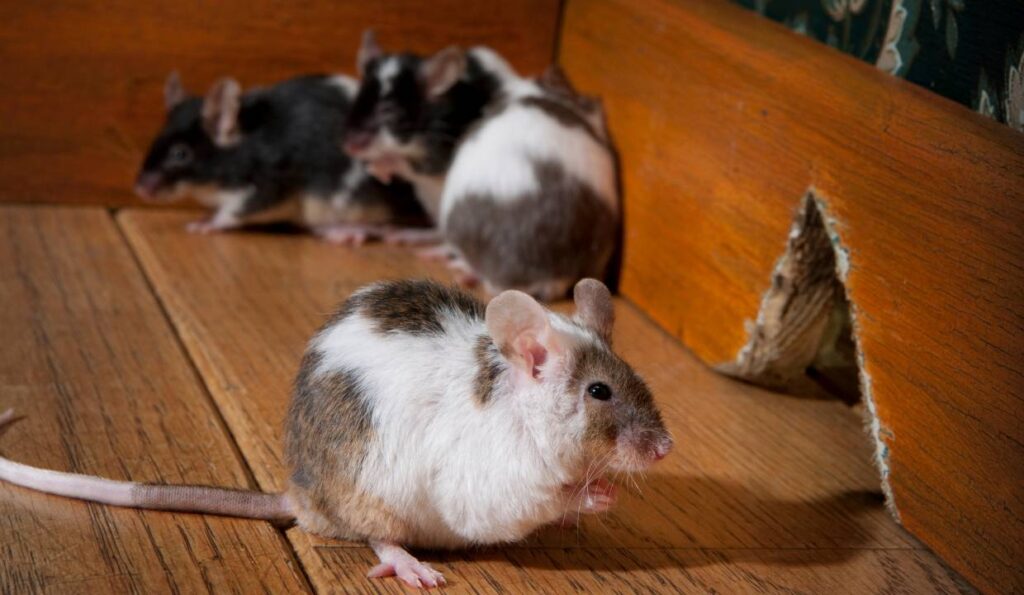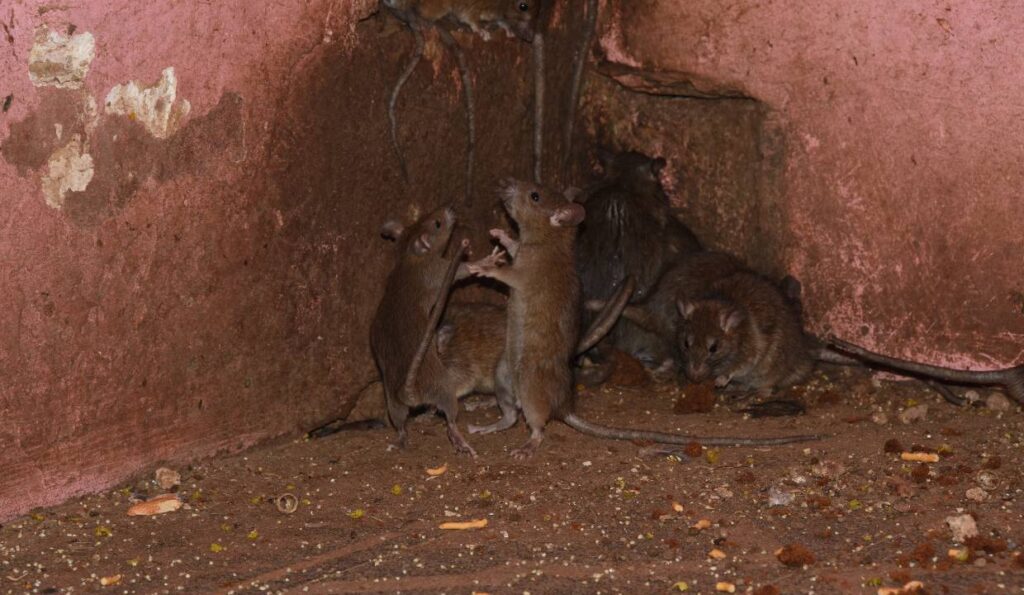Best Way to Get Rid of Mice in Your Walls (Efficient Removal)
- Given their nocturnal activity, trapping, and removal, employing various traps is crucial for a pest-free home.
- Strategic trap placement and baiting techniques, using enticing substances like peanut butter, cheese, or chocolate, play a pivotal role.
- Preventing mouse infiltration requires sealing entry points with durable materials like steel wool. While DIY methods help, professional assistance ensures a thorough approach.
Getting rid of mice in your walls is a common issue that can lead to many problems if not taken care of. It’s important to understand how mice get into your walls and the risks that come with it.
Mice are really good at finding ways into homes to get shelter, food, and warmth. If you don’t deal with a small mouse problem quickly, it can become a big issue because mice reproduce fast. They’re sneaky and usually active at night, making them hard to spot during the day.
Getting rid of mice involves trapping and removing them from your walls. There are different types of traps, like snap, glue, and electric traps. You need to pick the right one based on how many mice you have and where they are in your home.
How To Get Rid of Mice in Your Walls?
The best way to get rid of mice in your walls is with a two-pronged approach: seal entry points to prevent them from getting in and use traps and repellents to eliminate existing mice and deter them from returning.
Mice, adept at infiltrating homes for shelter, food, and warmth pose a rapid reproduction threat that can escalate into a full infestation if not promptly addressed. As nocturnal creatures, they expertly hide during the day and become active at night.
Trapping and Removal
Effectively trapping and removing mice from walls is a key component of mouse control. Understanding the types of traps, proper placement, and baiting techniques is essential for successful intervention.
Types of Traps for Mice in Walls

Selecting the right type of trap is crucial for successful mouse removal. Common types include:
- Snap traps
- Glue traps
- Electric traps
- Multiple-catch traps
Consider the infestation’s size, the mice’s location, and your preferences when choosing the most suitable trap.
Proper Trap Placement for Maximum Effectiveness
Placing traps strategically enhances their effectiveness. Focus on areas with high mouse activity, such as
- Along walls and baseboards
- Near entry points
- In dark corners and concealed spaces
- Along known travel routes
Regularly inspect and reposition traps for optimal results.
Baiting Techniques
Baiting techniques involve strategically selecting and deploying enticing substances to attract a target, often employed in various contexts, including pest control. In the realm of mouse trapping, the choice and presentation of bait play a crucial role in achieving successful outcomes.
- Choosing the Right Bait: Select from common options such as peanut butter, cheese, chocolate, seeds, or nuts. Experiment with different baits to identify what works best in your specific situation.
- Maximizing Bait Attraction:
- Use small amounts to prevent mice from stealing it without triggering the trap.
- Secure the bait to the trap’s trigger mechanism.
- Refresh bait regularly to maintain its appeal.
Ensuring enticing bait increases the likelihood of successful trapping.
Animal-friendly trapping
For those seeking humane solutions, live traps allow for the capture of mice without causing harm. You can find live-catch traps with one-way doors and multiple-catch traps for capturing several mice simultaneously.
Pros of Animal-friendly trapping | Cons of Animal-friendly trapping |
Ethical treatment of mice | Requires regular monitoring to prevent stress or harm to captured mice |
Allows for release in a different location | May not be as effective for large infestations |
Evaluate the ethical considerations and practicality of humane trapping based on the severity of the infestation and your personal preferences.
Identifying Entry Points

Mice are skilled at exploiting even the smallest openings to access homes. Addressing these entry points is vital for effective mouse control.
Common Entry Points for Mice
To prevent mice infiltration, be aware of common entry points they exploit:
- Gaps around doors and windows
- Vents and exhaust openings
- Cracks in the foundation
- Gaps in exterior walls and siding
- Gaps around utility lines entering the home
Seal Cracks and Holes
Sealing entry points proactively denies mice access, preventing infestations and improving energy efficiency and structural integrity. Selecting the right materials is the best way to keep mice away from house. Durable and gnaw-resistant materials like steel wool, copper mesh, or rodent-resistant sealant, considering entry point location and size.
You can try cost-effective DIY methods for sealing, including:
- Steel wool or wire mesh to fill gaps
- Caulk or expanding foam for openings
- Door sweeps to seal gaps beneath doors
- Repairing damaged screens on windows and vents
While DIY methods to remove mice can be effective, professional assistance provides a thorough approach. Pest control experts know how to chase mice away, identifying hidden entry points, and use specialized materials to defend proactively against mice infestations.
Risks Associated with Mice in Walls

When mice find their way into your home’s walls, they pose serious risks:
- Structural Damage: Constant gnawing in walls can lead to hazardous outcomes such as fires and compromised structural integrity.
- Health Hazards: Diseases carried by mice, combined with contaminated air from droppings and urine, pose significant health risks, including Hantavirus, salmonellosis, and leptospirosis.
- Allergens and Asthma Triggers: Mice in walls can worsen respiratory issues, releasing allergens that trigger asthma and allergies in susceptible individuals.
- Unpleasant Odors: Decomposing mice or their waste in walls creates foul odors, making the living space unpleasant and unsanitary.
Signs of a Mouse Infestation
Early detection is crucial; watch for these signs:
- Scratching or Squeaking Sounds: Nocturnal scratching or squeaking sounds in walls or ceilings indicate mouse activity, reflecting movements, nesting, or communication.
- Droppings and Urine Odor: Small, pellet-like droppings along travel routes or near food sources, coupled with a musty urine odor, signal a mouse presence.
- Gnaw Marks on Wires or Furniture: Constant gnawing on various surfaces, including electrical wires and furniture, poses risks such as electrical fires, demanding prompt intervention.
Dealing with mice in your home is a common issue that can lead to problems if not addressed promptly. Understanding the dynamics of these infestations and the associated risks is crucial for effective mouse control.
Early Detection: The Best Defense Against Mice Infestation
When mice infiltrate walls, they pose serious risks, including structural damage, health hazards, allergens, asthma triggers, and unpleasant odors.
Early detection through signs like scratching sounds, droppings, urine odor, and gnaw marks is crucial for timely intervention.
DIY strategies may provide a temporary solution, but professional intervention brings a holistic approach. Pest control professionals possess the expertise to uncover concealed entry points and apply specialized materials for an effective defense against mice infestations.
Frequently Asked Questions About Best Way To Get Rid Of Mice In Your Walls
How do you get rid of mice in walls fast?
To get rid of mice in walls fast, use snap traps or electronic traps strategically placed along their active pathways and near entry points.
Why do mice scratch walls at night?
Mice scratch walls at night as part of their nocturnal activities, including nesting, communication, and exploration.
How long does it take to get rid of mice in walls?
The time it takes to get rid of mice in walls depends on factors like the extent of the infestation, chosen control methods, and how promptly intervention is initiated; it can range from a few days to several weeks.